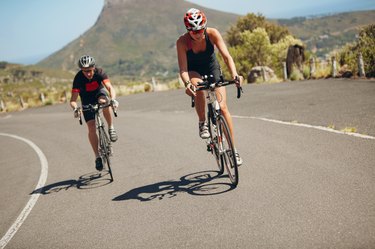
Proper positioning on a bicycle can eliminate almost all of the pain associated with riding. While longer rides will always take some toll on your muscles, riding a bike should not be a painful activity. Analyzing the way you sit on the bike and correcting an improper position will improve your comfort and increase your efficiency and power. Riding a bicycle properly fitted by an accredited bike fitting professional will also help you.
Sizing Up
Video of the Day
Ride a properly sized bike. If your bike frame is too small or too large for your proportions, you won't be able to sit properly. Bike frames are measured based on your pubic bone height, which closely resembles your inseam. To find this measurement, use a measuring tape to find the distance from the bony protrusion between your legs, just behind your genitals, to the base of your heel along the inside of your leg. Once you've got your pubic bone height, you can match it to a manufacturer's size chart to find the frame size that matches best with your measurement. If your measurement falls in between two sizes, it's best to size down so you can make up the difference by adjusting the seat height and stem.
Video of the Day
Back In The Saddle
Setting your seat height properly will probably correct most of your position issues. To find the ideal seat height, you'll want to lean the bike against a wall and mount it in place. Then, adjust the height using the quick release or an allen key until the seat is high enough so that when you are on the bike, your knee is just slightly bent when your pedal is in its lowest position during your pedaling stroke. Though you don't want to have to strain to reach the pedals, bending too much at the knees will be much harder on your joints and make your effort much less efficient.
Lean Into It
As you lean forwards to meet the handlebars with your hands, your body will form a sort of triangle shape, with your head at the apex. This position distributes weight between your sit bones in your pelvis and your hands, allowing your back to absorb the vibration and jarring from riding without strain. Keep your elbows slightly bent so that your arms can absorb the bumps from your ride, and keep your neck and shoulders relaxed. If you're having trouble reaching the handlebars or all the positions in your drop bars, you can use a shorter or higher stem to bring them closer to the bike.
Positioned for Victory
Proper sitting position is crucial on a road or racing bike for transitioning to different positions on the drop bars. If your bike fit is dialed in and your sitting position is correct, you should be able to tilt slightly at the pelvis to take a more aggressive riding position when you move your hands to the lower area of your drop bars. This makes your body shape much more aerodynamic, which can make a big difference at high speeds. The dropped position is also one of the most stable on the bike, giving you unparalleled control for that final sprint to the finish line. Keep adjusting your bar height and seat tilt until you can reach all positions on your drop bars without discomfort or strain.
- Sheldon Brown: Bicycling and Pain
- REI: Fitting Your Bike
- Rivendell Bicycle Works: Choosing a Frame Size
- Bike Radar: How To Get Your Seat Height Right
- Bike Radar: Health: Are You Sitting Comfortably?
- Nicole Oh, Pearson Physiotherapy: Is Cycling Proving To Be A Pain In The Neck?
- BikeFit: How to Fit a Road Bicycle
- REI: Bicycles: How to Choose
- Outdoor Gear Lab: The Best Bike Saddle